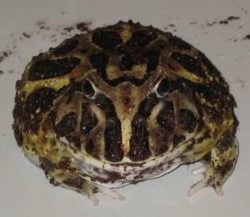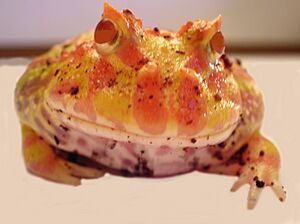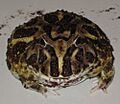Cranwell's horned frog facts for kids
Quick facts for kids Cranwell's horned frog |
|
|---|---|
 |
|
| Conservation status | |
| Scientific classification |
The Cranwell's horned frog (Ceratophrys cranwelli), also known as the Chacoan horned frog, is a type of frog that lives on land. It belongs to the family called Ceratophryidae. These frogs are found only in the dry Gran Chaco area, which includes parts of Argentina, Bolivia, Paraguay, and Brazil.
Like other frogs in its group, Ceratophrys, it's often called a Pac-man frog. This is because its big, round mouth looks a lot like the famous video game character. Most adult Cranwell's horned frogs are about 8 to 13 centimeters (3 to 5 inches) long and can weigh up to 0.5 kilograms (1.1 pounds).
Contents
What's in a Name?
The scientific name, cranwelli, was chosen to honor an Argentinian expert on amphibians and reptiles named species:Jorge A. Cranwell.
How Does it Look?
The Cranwell's horned frog usually has dark green and brown colors on its back. These colors help it blend in with its surroundings. This is important because it often burrows into the ground and waits for its food.
You can also find special versions of these frogs that are albino. This means they have orange and yellow colors instead of dark ones. These colorful frogs are very popular as pets.
Even though these frogs don't move around much, they are very good at catching food. They can jump several times their own body length to grab their prey. They use their sticky tongue to hold onto their meal and their heavy body to stay in place while they eat.
What Do They Eat and How Do They Behave?
Cranwell's horned frogs are nocturnal, meaning they are active at night. During the day, they rest with their eyelids open. They are meat-eaters and mostly munch on insects. They also eat other animals that are about their size, like small rodents. Sometimes, they even eat other frogs!
Big Cranwell's horned frogs have a very strong bite. Their bite can be as powerful as some mammals that hunt. They can even eat animals that are almost half their own size. Once they bite, they can't easily let go because they have a row of teeth on their upper jaw. This can sometimes cause them to choke if they try to eat something too big.
How Do They Handle Extreme Temperatures?
When the weather gets too hot or too cold, the Cranwell's horned frog goes into a special resting period called estivation. During this time, it grows a thick, protective layer of skin. This skin helps it keep moisture inside its body and also helps it breathe.
When the weather gets better, the frog uses its front and back legs to help shed this old skin. Often, it uses its mouth to pull the skin off its back and then eats the skin!
Can You Keep Them as Pets?
Cranwell's horned frogs are very popular pets, just like other Pacman frogs. If you keep one, it needs a humid place to live, like an aquarium with moist dirt or coconut fiber (not gravel).
They should eat a mix of different foods. Young frogs need to be fed every 1 to 2 days until they are about 18 months old. After that, adult frogs only need to eat once every 4 to 7 days. It's also a good idea to put a special calcium and vitamin powder on their food a few times a week. This helps them grow strong bones and stay healthy.
Because they have such big mouths, young Cranwell's horned frogs can sometimes swallow things they shouldn't. This can lead to a problem called impaction. This happens when something gets stuck in their tummy or intestines. For pet frogs, this is often a small rock or piece of gravel from their tank. Impaction can make them constipated and stop them from getting enough food. If it's not treated, it can be very serious. Sometimes, if there's too much stuff in their intestines, it can even make it hard for them to breathe.
Images for kids
See also
 In Spanish: Escuerzo de Cranwell para niños
In Spanish: Escuerzo de Cranwell para niños




